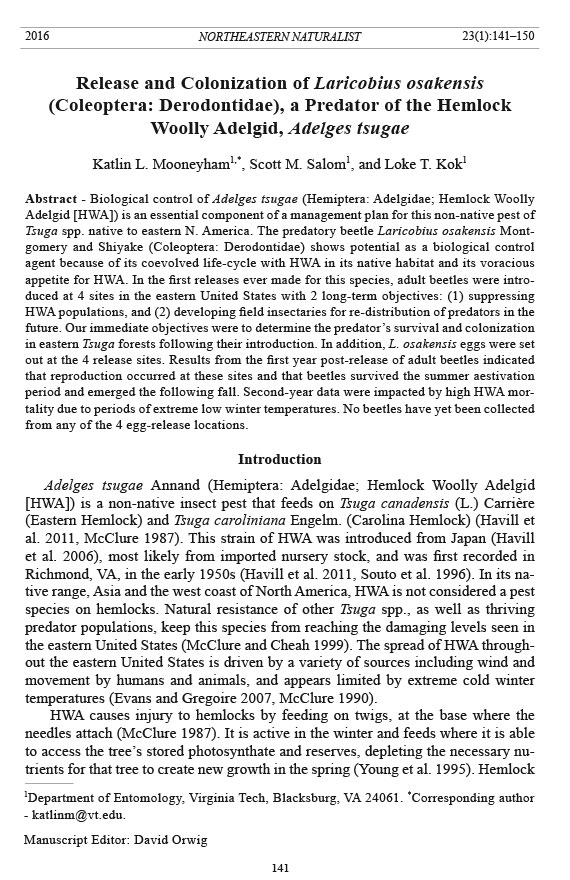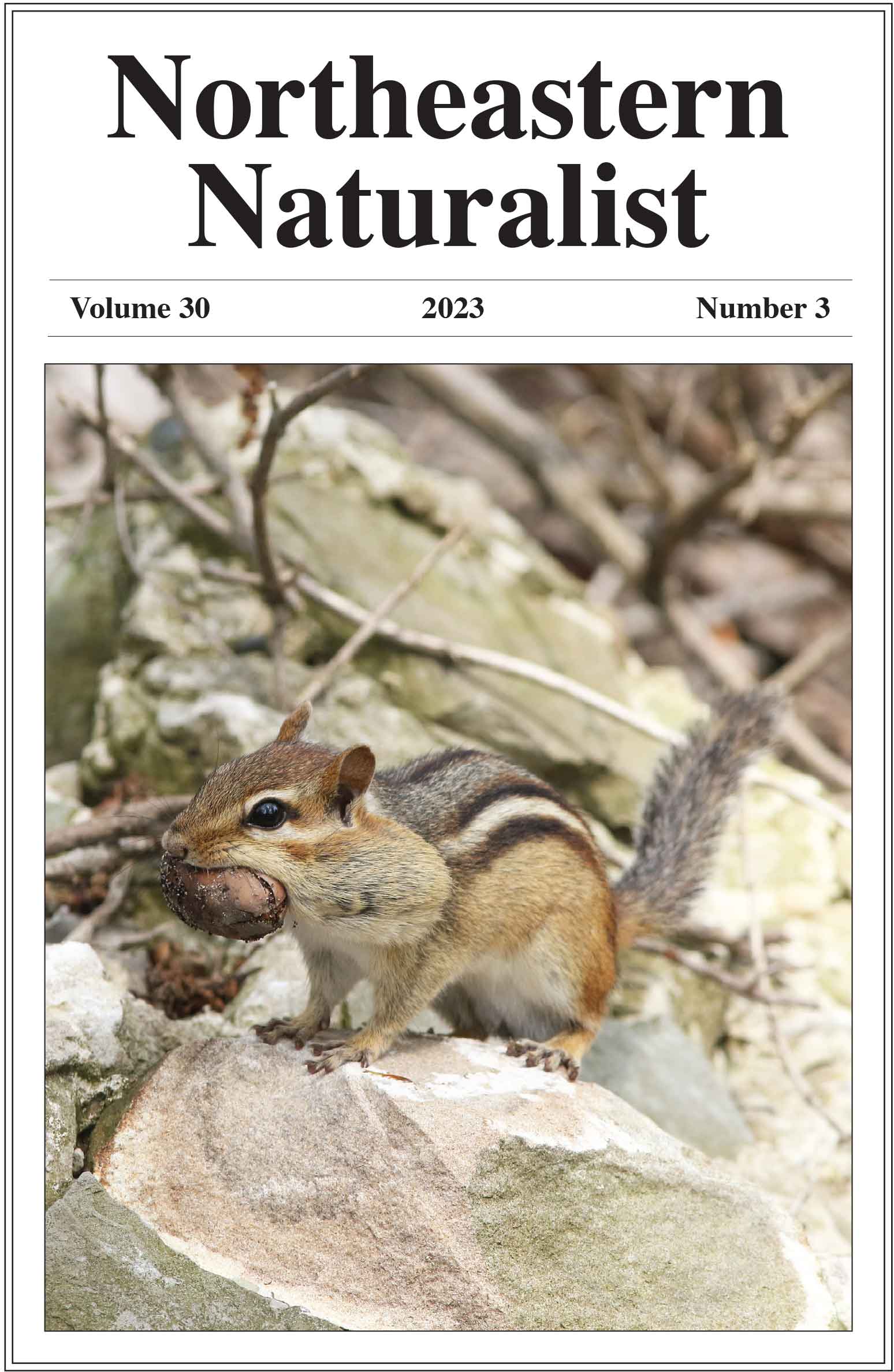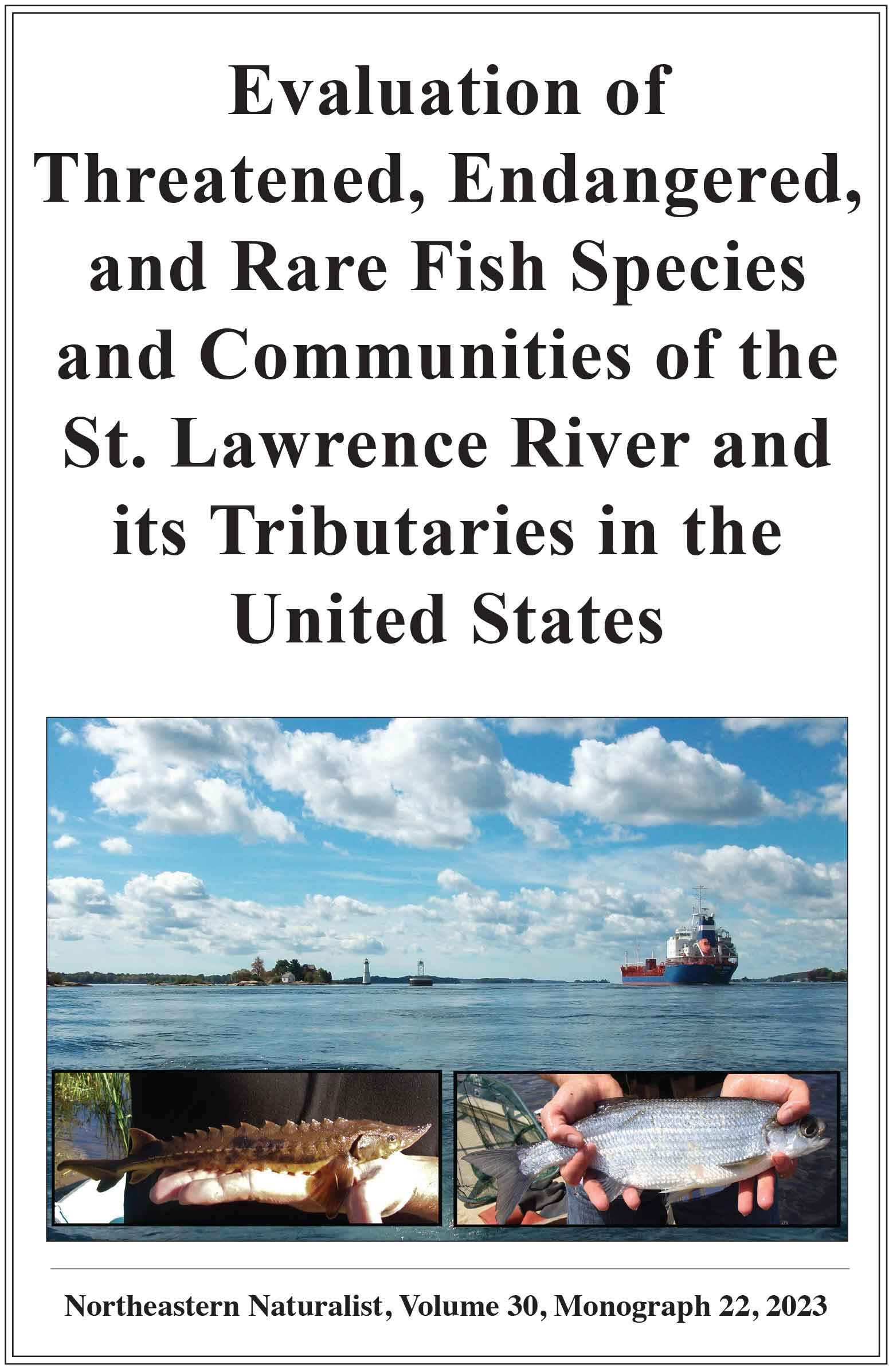Release and Colonization of Laricobius osakensis (Coleoptera: Derodontidae), a Predator of the Hemlock
Woolly Adelgid, Adelges tsugae
Katlin L. Mooneyham, Scott M. Salom, and Loke T. Kok
Northeastern Naturalist, Volume 23, Issue 1 (2016): 141–150
Full-text pdf (Accessible only to subscribers. To subscribe click here.)

Access Journal Content
Open access browsing of table of contents and abstract pages. Full text pdfs available for download for subscribers.
Current Issue: Vol. 30 (3)

Check out NENA's latest Monograph:
Monograph 22









Northeastern Naturalist Vol. 23, No. 1
K.L. Mooneyham, S.M. Salom, and L.T. Kok
2016
141
2016 NORTHEASTERN NATURALIST 23(1):141–150
Release and Colonization of Laricobius osakensis
(Coleoptera: Derodontidae), a Predator of the Hemlock
Woolly Adelgid, Adelges tsugae
Katlin L. Mooneyham1,*, Scott M. Salom1, and Loke T. Kok1
Abstract - Biological control of Adelges tsugae (Hemiptera: Adelgidae; Hemlock Woolly
Adelgid [HWA]) is an essential component of a management plan for this non-native pest of
Tsuga spp. native to eastern N. America. The predatory beetle Laricobius osakensis Montgomery
and Shiyake (Coleoptera: Derodontidae) shows potential as a biological control
agent because of its coevolved life-cycle with HWA in its native habitat and its voracious
appetite for HWA. In the first releases ever made for this species, adult beetles were introduced
at 4 sites in the eastern United States with 2 long-term objectives: (1) suppressing
HWA populations, and (2) developing field insectaries for re-distribution of predators in the
future. Our immediate objectives were to determine the predator’s survival and colonization
in eastern Tsuga forests following their introduction. In addition, L. osakensis eggs were set
out at the 4 release sites. Results from the first year post-release of adult beetles indicated
that reproduction occurred at these sites and that beetles survived the summer aestivation
period and emerged the following fall. Second-year data were impacted by high HWA mortality
due to periods of extreme low winter temperatures. No beetles have yet been collected
from any of the 4 egg-release locations.
Introduction
Adelges tsugae Annand (Hemiptera: Adelgidae; Hemlock Woolly Adelgid
[HWA]) is a non-native insect pest that feeds on Tsuga canadensis (L.) Carrière
(Eastern Hemlock) and Tsuga caroliniana Engelm. (Carolina Hemlock) (Havill et
al. 2011, McClure 1987). This strain of HWA was introduced from Japan (Havill
et al. 2006), most likely from imported nursery stock, and was first recorded in
Richmond, VA, in the early 1950s (Havill et al. 2011, Souto et al. 1996). In its native
range, Asia and the west coast of North America, HWA is not considered a pest
species on hemlocks. Natural resistance of other Tsuga spp., as well as thriving
predator populations, keep this species from reaching the damaging levels seen in
the eastern United States (McClure and Cheah 1999). The spread of HWA throughout
the eastern United States is driven by a variety of sources including wind and
movement by humans and animals, and appears limited by extreme cold winter
temperatures (Evans and Gregoire 2007, McClure 1990).
HWA causes injury to hemlocks by feeding on twigs, at the base where the
needles attach (McClure 1987). It is active in the winter and feeds where it is able
to access the tree’s stored photosynthate and reserves, depleting the necessary nutrients
for that tree to create new growth in the spring (Young et al. 1995). Hemlock
1Department of Entomology, Virginia Tech, Blacksburg, VA 24061. *Corresponding author
- katlinm@vt.edu.
Manuscript Editor: David Orwig
Northeastern Naturalist
142
K.L. Mooneyham, S.M. Salom, and L.T. Kok
2016 Vol. 23, No. 1
death is slow and prolonged due to HWA feeding and the cyclical populations of
the adelgids as they grow and feed intensively and then decline along with hemlock
health (McClure 1991). These insects do not discriminate between size and age of
hemlocks, and thus all trees are susceptible. Damage appears on the trees as bud
mortality, foliage discoloration, and overall loss of needles (USDA 2008). Loss of
hemlocks in the forest changes the forest canopy structure, species composition, and
forest soil temperatures (Jenkins et al. 1999, Orwig and Foster 1998).
Establishment of a classical biological control program became a priority in the
effort to develop means of suppressing HWA (Mausel et al. 2010, Onken and Reardon
2011). Classical biological control is the importation of natural enemies from
the native range of the pest species where they control the insect below damaging
levels (Clausen 1951, Dahlsten and Mills 1999, Franz 1961, Hall and Ehler 1979).
HWA is ideal for biological control because of its immobile lifestyle and easy access
for predation due to its persistence on trees for extended periods of time.
Predators of HWA from both Asia and the United States have been evaluated
since the mid-1990s (Onken and Reardon 2011, Wallace and Hain 2000). Initially,
3 predators were seriously evaluated for their potential as control agents: Scymnus
sinuanodulus Yu & Yao (Coleoptera: Coccinellidade), Sasajiscymnus tsugae
Sasaji (Coleoptera: Coccinellidade), and Laricobius nigrinus Fender (Coleoptera:
Derodontidae) (Mausel and Salom 2013). Members of the genus Laricobius have
been studied for their potential as biological control agents since 1997 because they
are known to be adelgid specialists (Vieira et al. 2011, Zilahi-Balogh et al. 2002).
While L. nigrinus has clearly been the most successful of the 3 original predators, in
terms of establishment and spread (Mausel et al. 2010), only 2 site-specific studies
have been able to assess the short-term impacts of the predator (Mausel et al. 2008,
Mayfield et al. 2015).
In a continued effort to find and utilize the most effective biological control
agent available, Laricobius osakensis Montgomery and Shiyake (Coleoptera: Derodontidae),
native to the same location where the HWA that invaded the eastern
United States originated, is one such predator currently being evaluated (Havill
et al. 2006, Montgomery et al. 2011). First found on Tsuga sieboldii from a sampling
effort that took place in the Kansai region of Japan in 2005 (Montgomery
et al. 2011), this predator has evolved with this strain of HWA. It is promising
as a biological control agent because of its increased predation and reproduction
compared with L. nigrinus (Vieira et al. 2012). Laboratory studies have shown
that L.osakensis does not impact L. nigrinus or the native L. rubidus, a predator of
Pineus strobi (Hartig) (Hemiptera: Adelgidae; Pine Bark Adelgid), through limited
predation on one another and because all 3 are compatible for predation on HWA
(Story et al. 2012). Additionally, while L. nigrinus and L. rubidus can successfully
hybridize, L. osakensis cannot produce viable eggs from mating with either (Fischer
et al. 2015). Both L. osakensis and HWA undergo an aestivation period at the same
time and have co-evolved life cycles as is expected with a predator that has a narrow
host-range (Vieira et al. 2013). This predator has a univoltine lifecycle, active
from November to April in its native range in Japan. Additionally, laboratory studies
Northeastern Naturalist Vol. 23, No. 1
K.L. Mooneyham, S.M. Salom, and L.T. Kok
2016
143
show that L. osakensis can only complete development on HWA, and is therefore
not a threat to other species native to eastern forests (Vieira et al. 2011). In 2010,
this species was approved for removal from quarantine by the USDA Animal and
Plant Health Inspection Service (APHIS) and subsequently was allowed to be released
(Lamb et al. 2011).
In this study, we considered both the number and life stage of L. osakensis
necessary to optimize release and colonization success. The methodology for field
release of L. osakensis is adapted from the protocol developed for L. nigrinus adults
by Mausel et al. (2010). All introductions of L. nigrinus were adult releases, except
in Georgia, where they have also been set out at the egg stage. The potential benefit
to releasing eggs is that it greatly reduces the effort needed to rear these beetles.
Given the similarities between climate in the southern Appalachians and that of its
native range in Japan, the primary objectives of this research were to determine
how well L. osakensis survives and colonizes in eastern forests. Additionally, we
hope to create a protocol for other forest-health professionals to use when releasing
these beetles on their own.
Methods
Field site description
Release locations for L. osakensis occurred on federal, state, and private lands.
Sites suitable for releases had the following attributes: >10 ha of forest primarily
composed of Tsuga spp., trees with high live-crown ratios, light to moderate HWA
infestation, and >2 km away from any previous L. nigrinus release locations. Trees
receiving L. osakensis beetles were clustered around a central HWA infestation if
one could be located. We selected individual release trees on the basis that they
were light to moderately infested with HWA, had minimal crown decline, and had
foliage accessible from the ground for beat-sheet sampling. For each tree, we affixed
an aluminum tag at breast height for identification and attached flagging for
visibility within the stand.
In the fall of 2012, we released 500 adults at both the Little Meadows Hunt Club
(Giles County, VA) and Carnifex Ferry Battlefield State Park (Summersville, WV).
To be able to compare colonization success of different release densities, we set out
80, 170, and 250 beetles on 3 separate trees, respectively, within each site. During
the fall of 2013, we released 2000 beetles at both the Clinch Mountain Wildlife
Management Area (Saltville, Russell County, VA) and the George Washington National
Forest (Goshen, VA). We set out 250 beetles on each of 8 trees at both sites.
All field introductions of beetles during 2012–2013 occurred in November, corresponding
to when the sistens generation breaks diapause. Differences in numbers
released per site in 2012 compared to 2013 were due largely to the availability of
beetles from the Virginia Tech Insectary.
Predators released
The L. osakensis beetles used for field release were lab-reared adults from beetles
collected in northern Japan from HWA-infested Tsuga sieboldii Carr. (Southern
Northeastern Naturalist
144
K.L. Mooneyham, S.M. Salom, and L.T. Kok
2016 Vol. 23, No. 1
Japanese Hemlock). Laboratory rearing of these beetles took place at the Virginia
Tech Insectary, utilizing methods established for L. nigrinus (Lamb et al. 2005). In
the fall, after adults emerged from the soil, they were held in 3.8-L containers with
up to 50 beetles on HWA-infested Eastern Hemlock bouquets. Laricobius osakensis
beetles were given fresh HWA every two weeks up until the point where they
were released in the field. Adults were held in environmental chambers at 2–10 °C,
depending on day length, and at 70–90% relative humidity. Prior to release, we
checked the beetles to ensure none were missing appendages, showed abnormal
behavior, or exhibited low vigor.
Release methods
We qualitatively assessed tree health prior to release using 5 measures: percent
live-crown ratio, crown density, live tips, live branches, and percent new foliage
(Table 1). We determined percent live-crown ratio by examining the ratio of a hemlock’s
live crown in relation to that of its total height, crown density by examining
the percent live branches and foliage that blocks light from coming through the
crown, and percent new foliage, live branches, and live tips by visually estimating
what percent of branches had live foliage and what percent of those branches
contained new growth. In addition to the tree health measures, we determined the
average number of adelgids per branch tip by picking 10 branches 20 cm in length
at random and counting the number of live HWA on each branch (Table 1).
Prior to release, bouquets of HWA-infested hemlock were prepared at the Virginia
Tech Insectary. The bouquets were made up of 10–15 twigs (10 cm in length)
and held in ventilated escape-proof polyethylene containers (950 mL, Rex Tech
Corp., Kent, OH), which were sealed with parafilm. Each container contained approximately
50 beetles which we hand-carried to release sites in a cooler and kept
at an ambient temperature, approximately 18 °C, and shaded before release within
24 h of packaging. We placed the hemlock branches from the insectary that held
the predators on the release tree on branches that we had flagged because they contained
at least 20 HWA/15 cm. All predator releases occurred on clear days, with
little to no wind, and mild, cool temperatures.
We also set out L. osakensis eggs at each of the 4 field sites, but at different
locations from where adult releases took place, separated by a minimum of 1 km.
All egg introductions took place in March following adult releases that occurred
the previous November. The objective was to compare the success of colonization
Table 1. Mean health-index values for site trees and mean number of adelgids per branch for each of
the 4 release sites. All values given are means ± s.d. No. of adelgid given is per 20-cm branch.
%
live-crown % live % tips % new % crown No. of
Site Year ratio branches alive foliage density adelgid
Little Meadows, VA 2012 94 ± 2 88 ± 8 82 ± 13 73 ± 16 77 ± 6 16 ± 3
Carnifex, WV 2012 76 ± 10 82 ± 8 83 ± 11 88 ± 3 73 ± 16 15 ± 1
Goshen, VA 2013 81 ± 12 79 ± 11 83 ± 9 85 ± 5 74 ± 7 17 ± 2
Saltville, VA 2013 72 ± 15 81 ± 6 89 ± 5 83 ± 4 76 ± 10 15 ± 1
Northeastern Naturalist Vol. 23, No. 1
K.L. Mooneyham, S.M. Salom, and L.T. Kok
2016
145
from egg releases with colonization using the adult-release method. At each site,
we placed an estimated 1000 eggs on HWA-infested trees that had met the same
criteria as the infested trees where adult releases occurred. All sites had 10 HWAinfested
hemlocks selected for egg release. We attached ~5 HWA-infested branches
from the insectary (20–30 cm in length), each branch laden with approximately 5
L. osakensis eggs inside HWA ovisacs, to flagged branches on infested release trees
for a total of 100 eggs per tree.
Beat-sheet sampling for predators
We conducted beat-sheet sampling for L. osakensis once monthly from November
to May, 2012–2014, using canvas beat sheets (71 cm2, BioQuip, Rancho
Dominguez, CA). We examined branches in the lower canopy of both the release
tree and the surrounding non-release hemlocks within 20 m and recorded any
predators discovered. We placed beat sheets under the branches with high HWA
populations and then tapped the branches ~10 times with a stick. We identified,
recorded, and returned unharmed to the tree from which they fell all L. osakensis.
We sampled only on days when the temperature was above 0 °C, when the adult
Laricobius spp. are active (Zilahi-Balogh et al. 2003), and when it was not windy,
raining, or snowing. When sampling at each release site, we recorded the number
of adults, release tree, site conditions, and sample date.
Branch-clipping sampling procedure for larvae
Mausel et al. (2010) determined that field colonization of Laricobius was more
accurately assessed by sampling for larvae rather than adults. To use this method
for L. osakensis, we clipped branches once a year at each site, on each release tree,
in March or April, depending on when HWA oviposition was at its peak. We used
Eastern Redbud (Cercis canadensis L.) flowering as a phenological indicator to
guide the start of larvae sampling (Mausel et al. 2010). Using hand pruning shears,
we cut heavily infested branches on the assumption that they would most likely
have L. osakensis larvae within the ovisacs. Branches from all areas within reach
on each release tree were cut into 20–30 cm lengths, loosely placed in individually
labeled plastic bags (26.8 x 27.3 cm), and stored in a cooler within a covered
vehicle. We then transported the samples to the Virginia Tech Insectary where
each sample was put in a rearing funnel (Salom et al. 2012). After the L. osakensis
larvae developed through the 4 instars, they dropped as pre-pupae into mason jars
attached to the funnel. We inspected these funnels daily for larval drop. We counted
and recorded the larvae according to release tree and site, then moved them to soil
containers to undergo pupation and aestivation.
We placed dead larvae found during the funnel checks in a vial containing 99%
ethanol for later molecular analysis, since Laricobius larvae are morphologically
indistinguishable among species. We used the mitochondrial cytochrome oxidase
I (COI) gene for species identification (Davis et al. 2011). Partial cytochrome oxidase
subunit I (COI) was amplified for 21 Laricobius larvae recovered over the
2012–2013 field season. We performed amplification of the COI gene according to
protocols described by Davis et al. (2011) and Fischer et al. (2014).
Northeastern Naturalist
146
K.L. Mooneyham, S.M. Salom, and L.T. Kok
2016 Vol. 23, No. 1
Results
Annual field survey and Laricobius osakensis collection
The total number of adult beetles recovered at Little Meadows during the first
year (2012–2013) was 15, while the total number of adults at Carnifex was 4. We
collected no beetles at either site in March (Fig. 1A). The beetles recovered this
first season were all lab-reared adults from generation P1 released the previous
November. The sampling of these adults was to ensure that they were still active
and present during the first field season. During the 2013–2014 field season, we
recovered 2 adult F1 L. osakensis at Little Meadows and 5 at Carnifex (Fig. 1B).
During the first year, we recovered 209 larvae from Little Meadows and 8 from
Carnifex. Of the larvae recovered from the Little Meadows site, the majority (148)
was from the tree where 250 beetles were released. This trend did not hold up, as
the second greatest amount of larvae drop (48) came from the tree where the least
amount of adults was released (80). The release tree where 170 adults were released
had the least amount of larval drop (13). The Carnifex site followed the same trend.
The 250-adult release tree had 5 larvae drop, the 80-adult release tree had 2, and the
170-adult tree had 1. Molecular analysis on a subsample of these larvae found 14
of the 21 larvae collected to be L. osakensis and 7 to be the native L. rubidus. We
clipped branches in the 2014 and 2015 field seasons to monitor F2 larvae from the
F1 adults, but no larvae dropped during these field seasons.
The total number of P1 adult beetles recovered at the Saltville field site the first
year (2013–2014) was 7, while the total number recovered at Goshen was 1 (Fig.
1B). Branches were clipped to monitor larval drop, however no larvae were ever
recovered from either of these field sites during spring of 2014 .
We released eggs at Little Meadows and Carnifex in 2013 and Goshen and
Saltville in 2014. Beat-sheet sampling from the release trees the following fall
after release did not result in the recovery of any adult L. osakensis beetles from
any of the sites.
Figure 1. Number of adult Laricobius osakensis recovered in Virginia and West Virginia
during the 2012–2013 field season (A) and the 2013–2014 field season (B) by release site
( LM = Little Meadows Hunt Club in Giles County, VA: CAR = Carnifex Ferry Battlefield
State Park in Summersville, WV; SALT = Clinch Mountain Wildlife Management Area in
Saltville,VA; and GOSH = George Washington National Forest in Goshen, VA).
Northeastern Naturalist Vol. 23, No. 1
K.L. Mooneyham, S.M. Salom, and L.T. Kok
2016
147
Discussion
Beat-sheet sampling to monitor the colonization of L. osakensis yielded positive
results during the first field season at each site. We recovered adult P1 beetles
throughout the field season after release, as well as larvae showing that the released
beetles were reproducing in the field. It is known that beat-sheet sampling is difficult
for small, hard to find insects and that non-recovery of these beetles does not confirm
their absence (Mausel et al. 2010, Venette et al. 2002).
A critical issue with the recovery of adult beetles was the extreme winter temperatures
experienced during the 2014 field season. Winter temperatures reached as
low as -25 °C in certain regions of Virginia and caused considerable adelgid mortality
(T. McAvoy, Virginia Tech University, Blacksburg, VA, 2014, unpubl. data). We
brought branches infested with HWA back from the Carnifex site in January 2014
and found 99% HWA mortality at this site. This high incidence of mortality might
explain the lack of recovery for both L. osakensis adults and larvae.
The loss of prey and cold weather together likely caused the decline in L. osakensis
adults recovered from December to May of 2014. After December, there was
a decrease in recovery numbers, which corresponded to the extreme cold winter
temperatures. Evidence suggests that beat-sheet sampling is less effective in the
winter than in the fall and spring (Zilahi-Balogh et al. 2003). The weather conditions
also explained the lack of larvae recovered during this time. The low recovery
of adult beetles could be the result of these beetles being intolerant of the freezing
temperatures experienced during the 2014 field season. Testing must be conducted
to determine the supercooling point of L. osakensis. The other contributing factor is
the lack of prey because the only way to sample for predators i s to find their prey.
The egg-release results from March of both 2013 and 2014 are still inconclusive,
as only 1 adult has been recovered thus far from all 4 sites. While it is much
easier to rear the beetles just through the egg stage versus through adulthood, the
lack of recovery suggests more sampling time is necessary to determine if this is
a reasonable alternate method for releasing L. osakensis compared with releasing
lab-reared adults.
Continued fieldwork is needed to assess establishment of L. osakensis over time
at each of the field sites. The ultimate goal is to create successful field insectary
sites where adult L. osakensis beetles can be collected and redistributed for release
at other impacted locations. Establishing these sites can take many years, as has
been the case with L. nigrinus (Mausel et al. 2010). This effort is designed to relieve
rearing pressure from insectaries. Colonization occurred at the first 2 release sites,
yet is hard to fully quantify due to the onset of consecutive harsh winters. These
difficult environmental conditions killed prey, which likely delayed establishment
of these predators. It appears that L. osakensis is suited for the eastern United States
because reproduction occurred naturally in the field as evidenced by the larvae
recovered at both initial release sites. Continued sampling is necessary to assess
L. osakensis colonization in the eastern United States. Measuring their success in
establishing viable populations as well as their impact on the ecosystem is critical
in determining their potential for suppressing HWA in the eastern United States.
Northeastern Naturalist
148
K.L. Mooneyham, S.M. Salom, and L.T. Kok
2016 Vol. 23, No. 1
The lack of recovery of L. osakensis in 2014 is not specific to this species of
Laricobius. For L. nigrinus, the numbers collected were directly related to the
number of HWA present (Mausel et al. 2008), we believe this helps explain our
observations with L. osakensis. As releases of L. osakensis continue throughout the
eastern US, continued monitoring will be needed to assess site-specific establishment,
dispersal, and population changes of the predator as it relates to its prey. This
paper reports on the initial release and partial colonization success of a promising
biological control agent for HWA.
Acknowledgments
We thank Tom McAvoy, Carrie Jubb, and Natalie Morris for all of their guidance and
help in the field and lab for this project. I would also like to thank the Little Meadows Hunt
Club, Carnifex Ferry Battlefield State Park, George Washington National Forest, and Clinch
Mountain Wildlife Management Area for their cooperation in completing this research on
their property. This research was supported by cooperative agreement # 12-CA-11420004-
070 between the USDA Forest Service and Virginia Tech and cooperative agreement #14-
8251-0305-CA between the USDA APHIS and Virginia Tech.
Literature Cited
Clausen, C.P. 1951. The time factor in biological control. Journal of Economic Entomology
44:1–8.
Dahlsten, D.L., and N.J. Mills. 1999. Biological control of forest insects. Chapter 29, In
T.S. Bellows and T.W. Fisher (Eds.). Handbook of Biological Control. Academic Press,
London, UK.
Davis, G.A., N.P. Havill, Z.N. Adelman, A. Caccone, L.T. Kok and S.M. Salom. 2011.
DNA barcodes and molecular diagnostics to distinguish an introduced and native Laricobius
(Coleoptera: Derodontidae) species in eastern North America. Biological Control
58:53–59.
Evans, A., and T. Gregoire. 2007. A geographically variable model of Hemlock Woolly
Adelgid spread. Biological Invasions 9:369–382.
Fischer, M. J., N.P. Havill, C.S. Jubb, S.W. Prosser, B.D. Opell, S.M. Salom, & L.T. Kok.
2014. Contamination delays the release of Laricobius osakensis for biological control
of Hemlock Woolly Adelgid: Cryptic diversity in Japanese Laricobius spp. and colonypurification
techniques. Southeastern Naturalist 13(6):178–191.
Fischer M.J., C.C. Brewster, N.P. Havill, S.M. Salom and L.T. Kok. 2015. Assessment of
the potential for hybridization between Laricobius nigrinus (Coleoptera: Derodontidae)
and Laricobius osakensis, predators of the Hemlock Woolly Adelgid (Hemiptera: Adelgidae).
Biocontrol Science and Technology 25:1467–1482.
Franz, J.M. 1961. Biological control of pest insects in Europe. Annual Review of Entomology
6:183–200.
Hall, R.W., and L.E. Ehler. 1979. Rate of establishment of natural enemies in classical biological
control. Bulletin of the Entomological Society of America 24:280–282.
Havill, N.P., M.E. Montgomery, G. Yu, S. Shiyake, and A. Caccone. 2006. Mitcochondrial
DNA from Hemlock Woolly Adelgid (Hemiptera: Adelgidae) suggests cryptic speciation
and pinpoints the source of the introduction to eastern North America. Annals of the
Entomological Society of America 99:195–203.
Northeastern Naturalist Vol. 23, No. 1
K.L. Mooneyham, S.M. Salom, and L.T. Kok
2016
149
Havill, N.P., M.E. Montgomery, and M.A. Keena. 2011. Hemlock Woolly Adelgid and its
hemlock hosts: A global perspective. Pp. 3–14, In B. Onken and R. Reardon (Tech. Coord.).
Implementation and Status of Biological Control of the Hemlock Woolly Adelgid.
FHTET-2011-04. USDA Forest Service, Morgantown, WV.
Jenkins, J.C., J.D. Aber, and C. Canham. 1999. Hemlock Woolly Adelgid impacts on community
structure and N-cycling rates in Eastern Hemlock forests. Canadian Journal of
Forest Resources 29:630–645.
Lamb A.B., S.M. Salom, and L.T. Kok. 2005. Survival and reproduction of Laricobius
nigrinus Fender (Coleoptera: Derodontidae), a predator of Hemlock Woolly Adelgid,
Adelges tsugae Annand (Homoptera: Adelgidae), in field cages. Biological Control
32:200–207.
Lamb, A., M.E. Montgomery, L.C. Vieira, S. Shiyake, and S. Salom. 2011. Laricobius
osakensis, a Hemlock Woolly Adelgid predator from Japan. Pp. 90–96, In B. Onken
and R. Reardon (Tech. Coord.) Implementation and Status of Biological Control of the
Hemlock Woolly Adelgid. FHTET-2011-04. USDA Forest Service, Morgantown, WV.
Mausel, D.L., and S.M. Salom. 2013. Hemlock Woolly Adelgid: Adelges tsugae Annand
(Hemiptera: Adelgidae). Pp. 167–187, In R. Van Driesche and R. Reardon (Eds.). The Use
of Classical Biological Control to Preserve Forests in North America. FHTET-2013-02.
USDA Forest Service, Forest Health Technology Enterprise Team, Morgantown, WV.
Mausel, D.L., S.M. Salom, L.T. Kok, and J.G. Fidgen. 2008. Propagation, synchrony, and
impact of introduced and native Laricobius spp. (Coleoptera: Derodontidae) on Hemlock
Woolly Adelgid in Virginia. Environmental Entomology 37:1498–1507.
Mausel, D.L., S.M. Salom, L.T. Kok, and G.A. Davis. 2010. Establishment of the Hemlock
Woolly Adelgid predator Laricobius nigrinus (Coleoptera: Derodontidae) in the eastern
United States. Environmental Entomology 39:440–448.
Mayfield III, A.E., B.C. Reynolds, C.I. Coots, N.P. Havill, C. Brownie, A.R. Tait, J.L. Hanula,
S.V. Joseph, and A.B. Galloway. 2015. Establishment, hybridization, and impact of
Laricobius predators on insecticide-treated hemlocks: Exploring integrated management
of the Hemlock Woolly Adelgid. Forest Ecology and Management 335:1–10.
McClure, M.S. 1987. Biology and control of Hemlock Woolly Adelgid. Bulletin 851. The
Connecticut Agricultural Experimental Station, New Haven, CT.
McClure, M.S. 1990. Role of wind, birds, deer, and humans in the dispersal of Hemlock
Woolly Adelgid (Homoptera: Adelgidae). Environmental Entomology 19:36–43.
McClure, M.S. 1991. Density-dependent feedback and population cycles in Adelges tsugae
(Homoptera: Adelgidae) on Tsuga canadensis. Environmental Entomology 20:258–264.
McClure, M.S., and C.A.S.J. Cheah. 1999. Reshaping the ecology of invading populations
of Hemlock Woolly Adelgid, Adelges tsugae (Homoptera: Adelgidae), in eastern North
America. Biological Invasions 1:247–254.
Montgomery, M.E., S. Shiyake, N.P. Havill, and R.A.B. Leschen. 2011. A new species of
Laricobius (Coleoptera: Derodontidae) from Japan with phylogeny and a key for native
and introduced congeners in North America. Systematics 104:389–401.
Onken, B., and R. Reardon (Eds). 2011. Implementation and Status of Biological Control of
the Hemlock Woolly Adelgid. FHTET-2011-04. USDA Forest Service, Morgantown, WV.
Orwig, D.A., and D.R. Foster. 1998. Forest response to the introduced Hemlock Woolly
Adelgid in southern New England, USA. Journal Torrey Botanical Society 125:60–73.
Salom, S.M., L.T. Kok, A.B. Lamb, and C. Jubb. 2012. Laboratory rearing of Laricobius
nigrinus (Coleoptera: Derodontidae), a predator of the Hemlock Woolly Adelgid [Hemiptera:
Adelgidae]. Psyche vol. 2012, doi:10.1155/2012/936519.
Northeastern Naturalist
150
K.L. Mooneyham, S.M. Salom, and L.T. Kok
2016 Vol. 23, No. 1
Souto, D.R., T. Luther, and B. Chianese. 1996. Past and current status of HWA in Eastern
and Carolina Hemlock stands. Pp. 9–15, In S.M. Salom, T.C. Tigner, and R.C. Reardon
(Eds.). First Hemlock Woolly Adelgid Review. US Department of Agriculture, Forest
Service, Morgantown, WV, Charlottesville, VA.
Story, H.M., L.C. Vieira, S.M. Salom, and L.T. Kok. 2012. Assessing performance and
competition among three Laricobius (Coleoptera: Derodontidae) species, predators of
Hemlock Woolly Adelgid, Adelges tsugae (Hemiptera: Adelgidae). Environmental Entomology
41:896–904.
US Department of Agriculture (USDA). 2008. Hemlock Woolly Adelgid infestations. 2008.
USDA Forest Service, Durham, NH.
Venette, R.C., R.D. Moon, and W.D. Hutchison. 2002. Strategies and statistics of sampling
for rare individuals. Annual Review of Entomology 47:143–174.
Vieira, L.C., T.J. McAvoy, J. Chantos, A.B. Lamb, S.M. Salom, and L.T. Kok. 2011. Host
range of Laricobius osakensis (Coleoptera: Derodontidae), a new biological control
agent of Hemlock Woolly Adelgid (Hemiptera: Adelgidae). Environmental Entomology
40:324–332.
Vieira, L.C., S.M. Salom, and L.T. Kok. 2012. Functional and numerical response of Laricobius
spp. predators (Coleoptera: Derodontidae) on Hemlock Woolly Adelgid, Adelges
tsugae (Hemiptera: Adelgidae). Biological Control 61:47–54.
Vieira, L.C., A.B. Lamb, S. Shiyake, S.M. Salom, and L.T. Kok. 2013. Seasonal abundance
and synchrony between Laricobius osakensis Montgomery & Shiyake (Coleoptera:
Derodontidae) and its prey, Adelges tsugae Annand (Hemiptera: Adelgidae), in Japan.
Annals of Entomological Society of America 106:249–257.
Wallace, M.S., and F.P. Hain. 2000. Field surveys and evaluation of native and established
predators of the Hemlock Woolly Adelgid (Homoptera: Adelgidae) in the southeastern
United States. Environmental Entomology 29:638–644.
Young, R.F., K.S. Shields, and G.P. Berlyn. 1995. Hemlock Woolly Adelgid (Homoptera:
Adelgidae): Stylet bundle insertion and feeding sites. Annals of Entomological Society
of America 88:827–835.
Zilahi-Balogh, G.M., L.T. Kok, and S.M. Salom. 2002. Host-specificity tests of Laricobius
nigrinus Fender (Coleoptera: Derodontidae), a biological control agent of the
Hemlock Woolly Adelgid, Adelges tsugae (Homoptera: Adelgidae). Biological Control
24:192–198.
Zilahi-Balogh, G.M.G., L.M. Humble, A.B. Lamb, S.M. Salom, and L.T. Kok. 2003. Seasonal
abundance and synchrony between Laricobius nigrinus (Coleoptera:Derodontidae)
and its prey, the Hemlock Woolly Adelgid (Hemiptera: Adelgidae). Canadian Entomologist
135:103–155.












